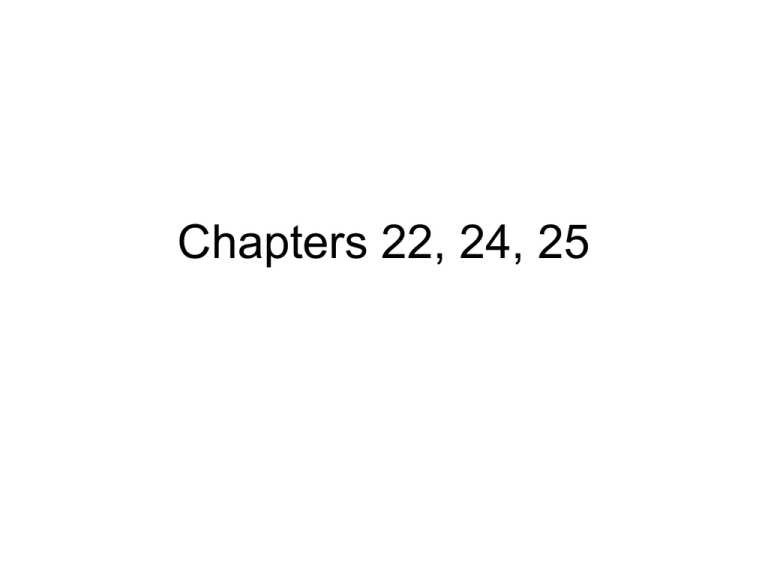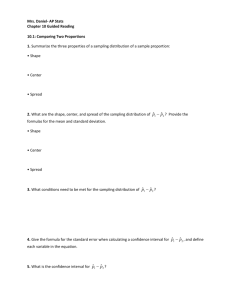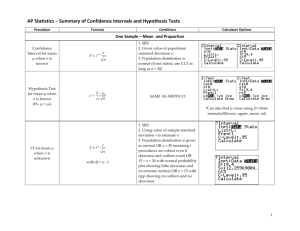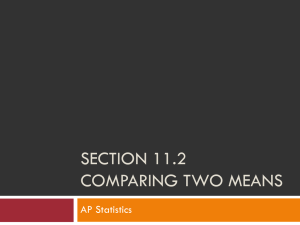Chapters 22, 24, 25
advertisement

Chapters 22, 24, 25 Notes Chapter 22 Comparing Two Proportions • Use when we want to compare the proportions from two groups of categorical data: • Conditions: *Both are SRS’s from populations of interest *n1 10% of population 1 n2 10% of population 2 *n1p1, n1(1-p1), n2p2, n2(1-p2) are all 10 For Confidence Intervals: (we do not assume that p1 = p2 therefore we do not pool for CI's) ( pˆ1 pˆ 2 ) z * pˆ1 (1 pˆ1 ) pˆ 2 (1 pˆ 2 ) n1 n2 *choose the non-pooled formula from chart, calculator will make correct choice automatically For Confidence Intervals: • Our confidence interval statements reflect the true difference in the two proportions (in context). For Significance/Hypothesis Testing Ho: p1 = p2 Ha: p1 p2 or p1 < p2 or p1 > p2 (Since our null states that p1 = p2, we assume this to be true until proven otherwise, therefore we automatically pool here) z pˆ1 pˆ 2 1 1 pˆ (1 pˆ )( ) n1 n2 Where x1 x2 pˆ n1 n2 *choose the pooled formula from the chart, the calculator will automatically pool We rely on the same p-values and alphas to make our conclusions. Notes Chapter 24 Comparing Two Means • When our data is quantitative, then we are either looking for an interval that contains their differences or we are comparing them to one another. Notes Chapter 24 Comparing Two Means • Two-Sample t Interval:(Quantitative Data) s s x x t n n 2 1 1 2 2 2 1 2 *choose the non-pooled formula from the formula sheet *df = there is a nasty formula – ick! But …calculator gives you this Notes Chapter 24 Comparing Two Means Two-Sample t-test t x1 x 2 s12 s 2 2 n1 n 2 *choose the non-pooled formula from the formula sheet *df = there is a nasty formula – ick! But …calculator gives you this Conditions: *The two groups we are comparing must be independent of each other. *Both n1 & n2 must be SRS from the populations of interest *Both n1 & n2 must be < 10% of their respective populations of interest *Sample size restriction must be met: If n1 + n2 < 15, do not use if outliers or severe skewness are present If 15 ≤ n1 + n2 < 30, use except in presence of outliers If n1 + n2 30, sample is large enough to use regardless of outliers or skewness by CLT Two-Sample t Procedures: • We do not pool t-tests. • Pooling assuming equal σ values. Since σ1 and σ2 are both unknown, why would we assume they are equal? • You must tell the calculator you do not want to pool. “Just say No”. • When we interpret confidence intervals we say “the true difference between two means” (not the mean difference). Notes Chapter 25 Paired Samples • Often we have samples of data that are drawn from populations that are not independent. We have to watch carefully for those!! We can not treat these samples as two independent samples, we must consider the fact that they are related. • So…what do we do? Notes Chapter 25 Paired Samples • If we have two samples of data that are drawn from populations that are not independent, we use that data to create a list of differences. That list of differences then becomes our data and we will not use the two individual lists of data again. Notes Chapter 25 Paired Samples • Once we have the list of differences, everything else is like 1 sample procedures from the last unit. • We will treat that list of differences as our data. • That list must meet the conditions for a single sample t-distribution. We will use the t-interval or the t-test on this list of differences depending on the question. • When we interpret our confidence interval or make our conclusion we will be talking about the “mean of the differences.” Reminders for Single Sample t Conditions: *Data is from an SRS of size n from the population of interest * Sample size < 10% of Population size *Sample is approx. normal/no outliers or large n (see guidelines below) • n < 15: Use t-procedures if the data is close to normal. If severe skewness or outliers are present, do not use t. • 15 ≤ n < 30 : The t-procedures can be used except in the presence of outliers • large n: The t-procedures can be used even for clearly skewed distributions when the sample is large (n 30) by CLT. The One-Sample t-Procedure: • A level C confidence interval for is: s X t n where t* is the critical value from the t distribution based on degrees of freedom. • To test the hypothesis: Ho: = o and Ha: > o Ha: < o Ha: o • Calculate the test statistics t and the p value. • We make the same conclusions based on p-values and alpha. • For a one-sample t statistic: X t s/ n has the t distribution with n – 1 degrees of freedom. • Just remember that all the variables represent the “mean difference” for your populations.







